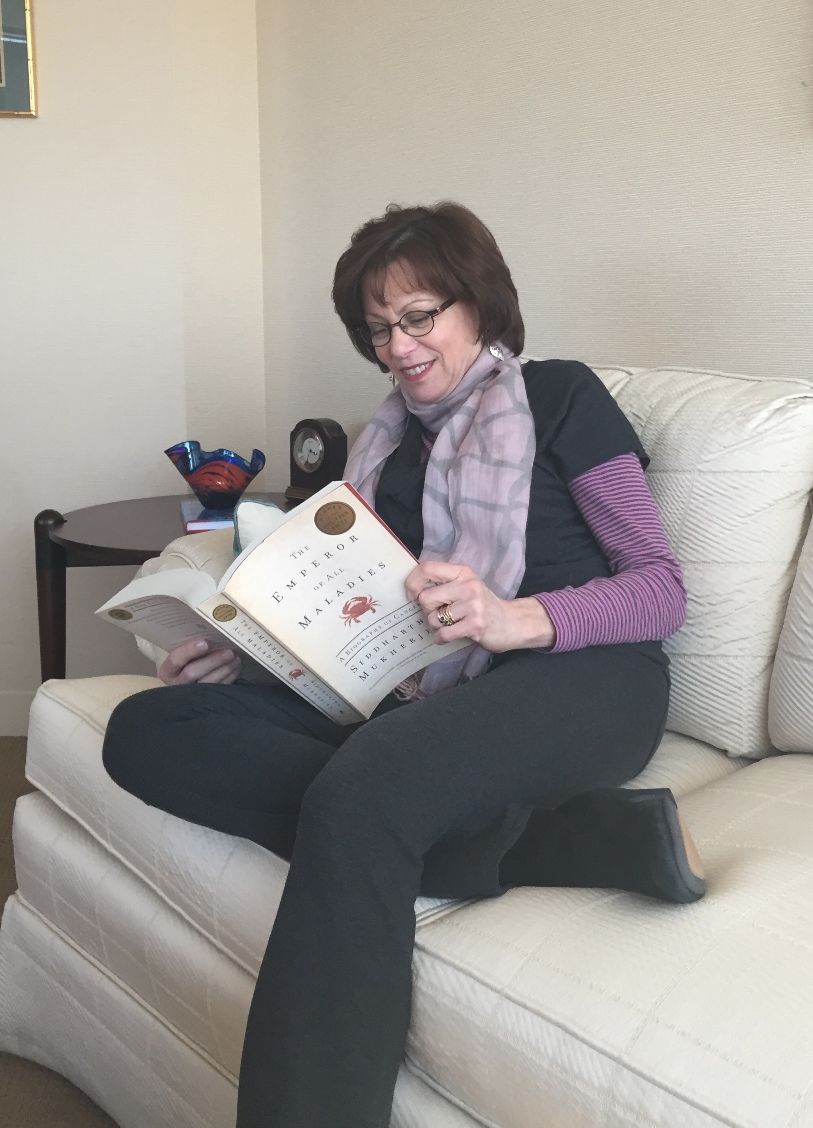
This blog is the second in a series.
I’m in the second-opinion hematologist’s waiting room, wondering why I’m only seeing doctors who specialize in blood. I’ve got cancer, not anemia.
The other thing that takes me aback is the ghostliness of the other denizens of this and the first doctor’s waiting room. They are all considerably older than I am, less mobile, and very, very pale. I feel as though I’ve stumbled into a waxworks. I have to consciously fend off a flight response; I feel fine. I am not of this world. This is all a mistake and I should just get up and leave. I whisper to my husband, who has accompanied me as a second set of ears, “Let’s get out of here. Now.”
Looking back on that initial visit, I’m embarrassed at my younger untutored self. I know now that my non-Hodgkin lymphoma(NHL) – and the 80 or so variations, and Hodgkin disease, plus all the varieties of leukemia, and several other afflictions – is a blood cancer. And it turns out that in the world of cancer, that qualifies as good news. Blood cancers are more accessible for researchers than many other cancers. Drawing blood for samples and follow up is much easier than doing biopsies of solid tumors. Advances in understanding and treating blood cancers are leading the progress toward cures not just for blood cancers, but are showing promise for other cancers as well. In fact, in the past 10 years, 40% of all the new cancer drugs approved by the FDA have been for blood cancers.
I know that now, but I didn’t then. I was just terrified.
I’m called in to see the doctor before I can escape – not that my husband would have let me. I sheepishly follow his nurse back to the small consultation room where the doc sits with my folder open on his desk; my life reduced to blood counts and pathology reports. Next lesson: staging. I had heard about this, and understood (thanks to the explanation of Doc #1) that it involved taking a core sample of bone marrow by essentially hand-drilling a hollow needle into the hip bone. It sounded neither pleasant nor painless and I assumed it would involve another wait while I agonized and prepared for it. However, this doc was all business. He leapt from his desk, called for his nurse and said, “Let’s go do it!”
No time to be a coward, I’m ushered into a procedure room where I unceremoniously present my right butt cheek for exploration. A quick spritz to numb the outside, and I squeeze my eyes shut to avoid any further glimpse of a needle that would be at home on a drilling rig. It’s a totally new sensation; not excruciating – more pressure than pain – and just at the point where it sneaks close to unbearable it’s over. As he extrudes the sample, the doc observes, “That’s a nice piece.” And I wisecrack, “Thanks, it’s not often I’m called that.” He guffaws and repeats the joke to his nurse. An appreciative audience! That’s all I need to decide that I’ll turn my cancer education over to him.
And what an education it was – Cancer 101 – learning all the absurd indignities of various treatments, where humor was my primary coping mechanism. Somehow I never imagined that a cancer diagnosis would have me spread-eagled on a radiation table, being tattooed on body parts not generally available for public viewing. Nor did I realize that I would have to “assume the position” every day, being gently pushed and prodded until the dots were in exact position relative to the radiation beam. Five days a week. Four weeks in a row. In defense, I’d try my lame jokes on each new technician by confiding, as they lined up the beam with the blue markers, “The tattoos are really helpful, actually – when my husband gets bored, he plays ‘connect the dots.’” Most were polite enough to laugh as though no one had ever said that before.
My initial diagnosis had been Stage 1a, so the first round of treatment was surgery to excise the lump followed only by the radiation. And that was quickly followed by a warning from my hematologist/oncologist that “It will come back. Indolent NHL is treatable but not curable. You’re not done.”
I countered, “But if I make it five years without a recurrence, doesn’t that mean I’m in remission?”
“Nope. It will come back.”
Part of me didn’t believe him. All of me didn’t want to believe him. But as my older and wiser self now knows, “Predicting outcomes for indolent… lymphomas is more difficult than for aggressive lymphomas. Even if treatment achieves a response, these tumors almost always recur.” Not only do they recur, but there is a risk that they will transform into a more aggressive type. Although that’s not necessarily bad news, since many aggressive forms of NHL can actually be cured, it seems odd that one would have to get sicker to get better, but cancer is a strange beast.
Researching this beast, I learned that science was advancing rapidly in terms of treating a wide range of blood cancers. That knowledge framed my new normal – a nagging sense of inevitability held in check by the hope that when/if I did relapse, the cancer landscape might look a bit different . I went two, three, four years. And just as I was approaching what I had convinced myself was the magical five-year mark, I was back in his office with another lump – same place, same size.
To his credit, he did not say “I told you so.”
This blog is the second in a series.
To read Blog 1: "Cancer in the Waiting Place," click here.
To read Blog 3: "About Time," click here..
